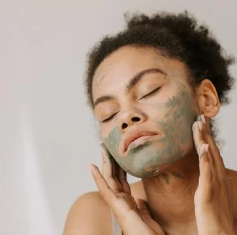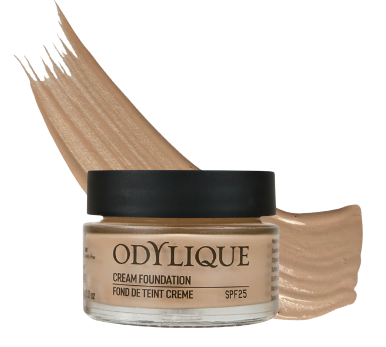It’s often said that application is of paramount importance when it comes to foundation. And for those of us with sensitive skin or skin prone to problems like eczema, it might feel a little daunting.
But it needn’t be. With the right products, routine and technique, you’ll be applying foundation like a professional in no time.
So here’s how to apply foundation so that ‘your skin looks stunning’ not, 'your foundation looks fine'.
1. Prepare your canvas
To put it bluntly, you wouldn’t paint a wall without prepping it first, and the same goes for your skin. A consistent skin care routine with regular cleansing, toning, moisturising – and exfoliating is key to achieving the best results from foundation.
Ideally once a week, give your skin a gentle exfoliation with a good mask, like our 3-in-1 Maca Mask. This removes dead skin cells that can give an uneven foundation finish and boosts skin repair.

Before you apply foundation, always cleanse your skin to unclog pores and remove any dirt that may be dulling your natural radiance. - Depending on your skin type, choose from our Creamy Coconut Cleanser (for normal to dry skin), Silk Touch Cleanser (for very dry skin), or Purifying Lemon & Tea Tree Wash for combination or oilier skin.
Next give your skin a little tonic to help close pores. Spray on one of our soothing rose water-based tonics and sweep over your face with a cotton pad.
If you have time, give yourself a facial massage with a jade roller to boost circulation and supercharge your natural glow.
2. Feed your skin
Foundation sinks best into hydrated skin. And moisturiser helps the foundation stay on for longer. Any of our 3 facial moisturisers will leave your skin feeling velvety smooth and nourished.
- Timeless Rose Moisturiser (lighter, for all skin types, or for summertime)
- 24H Avocado Replenishing Cream (a little richer, all skin types, or in-between the seasons)
- Prebiotic Rich Hydration Cream (deeply hydrating, mature skin, or ideal in winter)
Gently massage your moisturiser into the skin to boost circulation and reduce any puffiness. This is a great step if you don’t have time for the facial massage mentioned above. It creates a natural flush that makes you look more awake (even if you don’t feel it!). Let your moisturiser absorb for a couple of minutes.
If you want to use an SPF and your foundation doesn’t have one, now is the time to apply it.
3. Keep it simple
We don’t believe in using primer. Most primers are silicone-based and as a brand, we don't do silicone. A good moisturiser should do the job of a base layer for foundation.
Only apply foundation where it’s necessary. Always start by applying just a little bit of foundation, then add more until you have the right amount of coverage. Where blemishes are visible you can always apply an additional light layer of foundation in those specific areas.
The goal is that your skin still looks like skin. And if you need to apply foundation all over your face for it to look even, then you’re using the wrong shade.
For a very natural look, you can skip the bridge of the nose, letting any freckles show through.
Or for a just a skin tint, you can mix some foundations with a bit more of your moisturiser, and then apply it.
4. Start at the centre and move outwards in a dabbing motion
Dot foundation onto the apples of your cheeks and slowly move outwards. Similarly (if needed), put a dot of foundation on each side of your nose, and in the centre of your forehead and chin, then blend outward.
There’s a choice of tools for applying foundation. Depending on your preferred technique and desired finish, you could use a foundation brush, make-up sponge, stippling brush or your fingers.
But no matter what you’re using, tap or dab then buff the foundation onto your skin. Don’t paint, rub or wipe as this just pushes the foundation around and can create streaks.

How to apply foundation with a brush
If you’re looking for full coverage, a foundation brush allows for a quick, seamless application and you can easily layer up the product on those areas that need it.
Counterintuitively, do not be tempted to ‘paint’ with your brush. Instead, pump a little foundation onto the brush and use it to tap and dab the foundation into your skin.
How to apply foundation with a sponge
A dry sponge will drink up a water-based foundation. So before using, run your sponge under the tap and wring out any excess water.
Don’t wet the sponge if you’re using a water-free foundation – the water might not combine well with the oil base.
Pump or spatula a little foundation onto the sponge. Then gently dab or ‘bounce’ the sponge on to your skin, a process called stippling. Again, don’t rub or drag across the skin. Use the small, pointy tip of the sponge to stipple and buff the foundation around your nose and eyes
Keep your sponge clean and replace it every three months.
How to apply foundation with your fingers
The warmth of your fingertips can help make the skin and foundation melt together and appear seamless.
Make sure your hands are clean and then pump or spatula a little onto your fingertips. Always start with a small amount of foundation, then gently dot it onto your face. The motion again is patting and pressing gently into the skin. Do not rub or wipe it.
5. Buff and touch up
If you’re wearing the right shade of foundation, you shouldn’t have any harsh lines or a mask-like effect. Still, it’s a good idea to gently buff out the edges towards the hairline and jaw to fully diffuse the colour and ensure your foundation looks as natural and invisible as possible.
If there are any areas where your foundation wasn’t enough, such as dark undereye circles or blemishes, dab a little concealer over them, then tap it gently into your skin. Our mineral concealers are smooth and creamy for easy application and are available in 3 colours that marry well with a number of our foundation shades. They also contain zinc oxide to help tackle any blemishes.
If you need a little help creating your skincare routine, or choosing your foundation, get in touch with our experts here.




